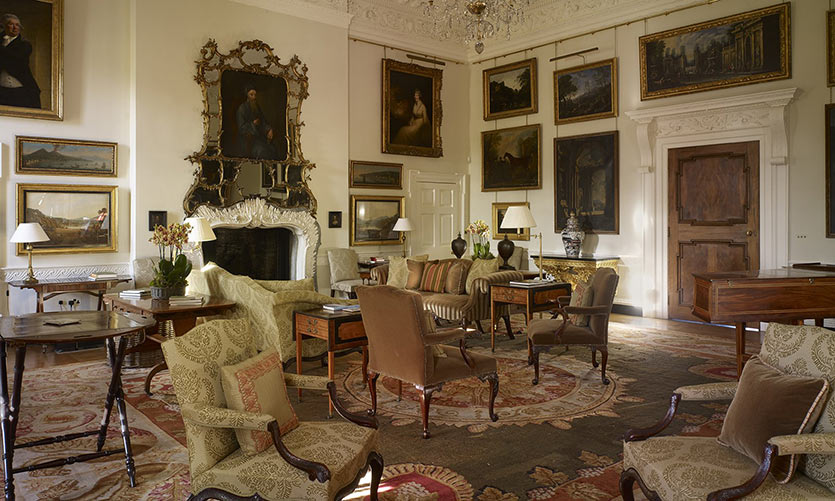Our annual Architectural Awards, generously sponsored by Savills, took place at the RIBA on 30 November this year. The Awards, now in their fifteenth year, recognise exemplary conservation and restoration projects in the UK and reward those who have shown the vision and commitment to restore Georgian buildings and landscapes. This year we were pleased to welcome Dr John Goodall as chair of the judging panel and presenter of the Awards. His Royal Highness The Prince of Wales, Patron of the Georgian Group, graciously provided the introduction to the Awards by means of a video message recorded at Dumfries House:
A Message Delivered by HRH The Prince of Wales on the occasion of the fifteenth Georgian Group Architectural Awards, in the Group’s 80th Anniversary year
As Patron of the Georgian Group it gives me great pleasure to welcome you to the fifteenth annual Architectural Awards, in the Group’s eightieth anniversary year. These Awards recognise exemplary conservation and restoration projects in the United Kingdom and reward those who have shown the vision and commitment to restore Georgian buildings and designed landscapes.
The preservation of the historic environment, at its best, is an act of altruism. If these Awards can be said to have had an overarching theme over the past fifteen years, it is that the overwhelming motivation for conservation is diligent and practical concern for the legacy we leave to the future. And so it is only right that these Awards celebrate the work of those involved, as much as the buildings themselves.
When so much of the Group’s time is spent trying to prevent harm to our Georgian heritage it is heartening to have an evening when we can celebrate those who have done their best, often expending considerable money, time and energy, to ensure that the buildings they care for are left in a better state than in which they were found. In the eightieth anniversary year of the Georgian Group it is indeed reassuring to find that the conservation of our Georgian heritage, while not without its challenges, is also not without its champions.
The preservation of the historic environment, at its best, is an act of altruismHRH The Prince of Wales
Restoration of a Georgian Landscape
Winner: Lowther Castle, Cumbria
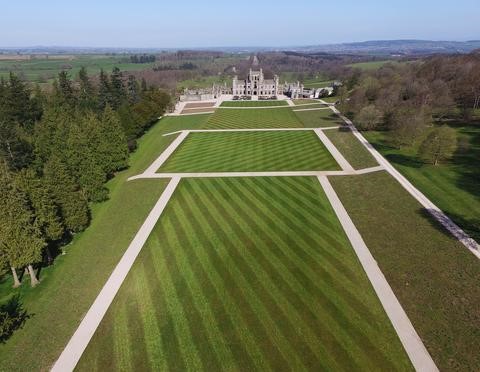
Client: The Lowther Castle and Gardens Trust
Landscape Design: Dan Pearson Studio
Architects: Fielden Clegg Bradley
Lowther Castle stands on a site occupied by the Lowther family for over 800 years. It sits in a 3,000 acre medieval deer park, which is part of a 75,000 acre agricultural estate within Cumbria's Lake District National Park. The Gothic Revival building, now partially ruined, was the third home to be built on the site. It was designed by Robert Smirke for the first Earl of Lonsdale and was completed in 1806.
After the castle was requisitioned by the army during the second world war the sixth Earl sold the castle contents in 1947. In 1957 the seventh Earl removed the roof and interior structures of the building, which was the only way to retain the building in some form whilst protecting the rest of the estate from a £25 million death duty bill. The gardens were then used to house a large chicken farm and commercial forestry business, with chicken sheds and Sitka spruce right up close to the castle ruins. The surrounding historic gardens were left to decay for forty years.
Dan Pearson Studios were first appointed in 2008 to provide a landscape and gardens masterplan for a Heritage Lottery Fund application for the cultural redevelopment of the castle and gardens. The original masterplan was then taken on by Land Use Consultants, who oversaw the initial stages of the resuscitation of the historic landscape, including the reinstatement of the historic South Lawn at the rear of the castle.
Since 2011 Dan Pearson Studios have developed and implemented several elements of the masterplan including a new Parterre Garden built on the site of the previous Lowther castle ruins, new plantings to the castle interior and landscaping of the Arrival Courtyard, which was planted with specimen hornbeam topiary in January 2017. A new Rose Garden on the site of the historic Rose Garden, is scheduled to open in 2018.
In conjuction with the landscape restoration, Feilden Clegg Bradley Studios have been working for the last four years to bring the castle itself back from abandonment. The shell of the castle ruin is now saved from near collapse and made safe for visitors to explore; the 400 year-old ‘hidden’ gardens are revealed and the derelict stables transformed into a vibrant centre for visitors and the community.
Community involvement and highly-skilled conservation craft have been critical drivers for this extraordinary project which has provided a focus for heritage skills and garden training.
The design of contemporary interventions, which have been discreetly integrated into the historic fabric, has been informed by the original palette of materials and construction techniques found in the castle. The Stable Courtyard has been painstakingly repaired and refurbished to provide visitor facilities including a 100 seat café, museum gallery, shops and education facilities.
The Sculpture Gallery, and West Range housing the Lowther Gallery and access to the castle ruin interior opened late summer 2012, while the gardens project is conceived as a long-term undertaking, with the initial three-year project establishing the framework for gardening in future. The gardens will thrive through the support and enthusiasm of local people who are taking the lead in shaping Lowther for the new century.
Highly Commended: Duncombe Park, Helmsley, North Yorkshire
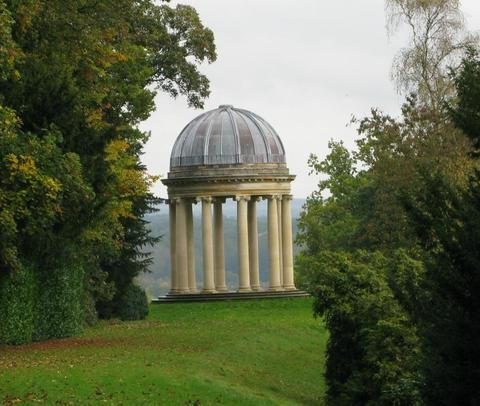
Client: The Hon Mr and Mrs Jake Duncombe
Lead Architect: Peter Pace Architects
From 2013 - 17 the Estate has concentrated bringing back one of the a major 18th Cent Landscapes on the Eastern side of Duncombe Park, involving urgent repairs to the Ionic Temple, and the Tuscan Temple, together with tree and Hedge work to the East Terrace, (connecting the two Temples) to regain views of the valley below with vistas of Helmsley Castle and other landmarks once again revealed.
The whole exercise has been one of both one of major building repairs and reinstatement of the Landscape.
The programme initiated by the Helmsley Estate, was finished in March this year, with support from Historic England, Natural England, the North York Moors National Park, The Country Houses Foundation, and Yorkshire Historic Gardens Trust.
The repairs to both Temples have involved the complete replacement of all the columns, capitals and bases – a decision taken after much thought and research. A paper on the assessment of stonework is attached with this submission. The work has required skilled masons and carvers of the highest standard. Long searches were conducted for the right replacement stones of sufficient bed height to allow natural bedding and the keeping to original joints. The project has taken time, and extended to include the interior redecoration of the Tuscan Temple with new floor in polished limestone to replace the previous concrete floor finish.
The project is submitted as a whole, and can be regarded as a very significant Landscape project, though the building repairs merit individual attention as well.
New Building in the Classical Tradition
Winner: Williamstrip Chapel, Gloucestershire
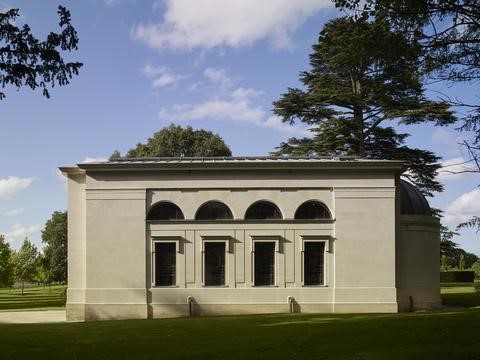
Client: Mr and Mrs John Kennedy
Architect: Craig Hamilton Architects
The construction of a new chapel for Williamstrip Park is a further phase in the overall restoration and remodeling of Williamstrip Park following the purchase of the property by the applicant in 2007. Alterations and restoration of the main house are complete, as is the completion of a new bath house to the north east of the main house. The gardens on the east and south side of the house have also been completed, together with the re-instatement of the park drive which approaches the house from the west.
The Chapel is intended to be a contemporary neo-classical building designed as a very restrained new building within the context of Williamstrip Park. The west entrance front presents itself as a stripped down Classical temple front in the most restrained manner. The mouldings around the entrance door are shallow recessed mouldings and the only element of decoration on this front is a bas relief, by Professor Alexander Stoddart. Above this relief is a semi-circular window which lights the vestibule. The north and south elevations are mirror images of each other and also are in a very pared down Classical manner. Each of these facades has four semi-circular windows with a very shallow modulation of masonry surrounding it. The east or apse elevation consists of plain ashlar with a lead roof over the domed apse. A discreet, small rooflight provides the only natural light to the sanctuary.
All four elevations are in natural fine rubbed ashlar. All external windows are natural bronze containing handmade glass. The only external door to the building is the entrance door on the west elevation and this is of bronze, also patinated a dark green colour. The detailing on the door contains very shallow recessed panelling.
The chapel is designed as a restrained new Classical building, built out of the finest materials and presents itself as a small traditional chapel within the grounds of the house. This new building in no way competes with the main house, but rather complements the newly designed gardens to the east and south of the house.
Highly Commended: Harris Manchester College Clock Tower and Gate, Oxford-Runner Up
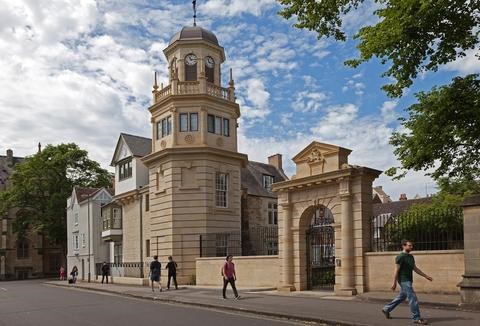
Client: Harris Manchester College
Architect: Yiangou Architects
The new clock tower and gate at Harris Manchester are an example of how student accommodation can be of the highest architectural quality, and enhance rather than harm the historic environment in which it sits. The new buildings at Harris Manchester draw on the legacy of English mannerism, cleverly reflecting the full gamut of Oxford mannerism from the seventeenth to late nineteenth centuries. The inscription on the clock tower-“it’s later than you think, but it’s never too late” might be seen as a timely reminder to the architectural profession that the worst excrescences of late twentieth century campus architecture need no longer serve as the model for future projects. Indeed, the work at Harris Manchester amply demonstrates that carefully considered and contextual classicism can be extremely effective on even the most limited and irregular of sites, and that bold new design does have a place in the historic realm, if informed by tradition and wit.
Restoration of a Country House
Winner: Pitshill House, West Sussex-Winner

Client: The Hon Mr and Mrs Charles Pearson
Architect: Simon Johnston
Pitshill sits at the head of a coomb, slightly askance to the spectacular view of the Downs to the south. The present building which replaced an older house, was begun by William Mitford in 1760 and completed by his son, William Mitford, in 1794. The architect was John Upton, Surveyor to the Earl of Egremont. The 1790s work was informed by the advice of Sir John Soane. Recent years had taken its toll, neglect and poorly judged building work allowing decay of the buildings and a return of the formal grounds to scrub.
The restoration was to reinstate the presence the house once had in the landscape along with the surviving contemporary buildings; a Shell House, a Prospect Tower, an Ice House and two picturesque drive Lodges. Simon Johnson oversaw the preservation of these historic structures as well as laying out a new formal garden to ‘answer’ Soane’s east front.
The intent to create a practical and comfortable family house has been achieved with the addition of a new bedroom floor, bathrooms, a lift and oval attic staircase; but the bulk of the original floor layouts are as left in the 1830s.
The house now has rooms that have been decorated and furnished in a way that befits so elegant a house and that will perhaps help Pitshill merit more than a footnote in future monographs on the work of Sir John Soane.
Highly Commended: Sandycombe Lodge, Twickenham
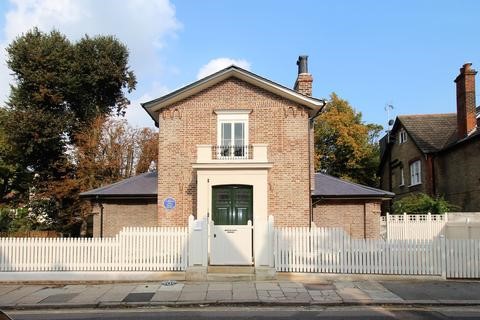
Client: Turner’s House Trust
Architect: Butler Hegarty Architects
In 1813 England’s great landscape painter JMW Turner built a small villa, Sandycombe Lodge, on a large plot near the Thames at Twickenham. Here, the painter became an architect, guided by the hand of his friend John Soane.
During the early stages of conservation work some amazing discoveries were made, making those involved rethink what we thought we knew about the appearance of Turner’s House. As we had all known it, Sandycombe was rendered stucco, and this seemed to be borne out by Havell’s drawing. But when upper rooms were removed there was no trace of render or paint. When more render was removed, it became apparent that when first built for Turner, Sandycombe was an unrendered and handsome brick building, with ‘penny struck’ pointing.
Sandycombe has been lightly furnished with objects from the early 19th century, using as a source contemporary accounts and information on the old-fashioned items listed in the inventory of his London house, taken after his death in 1851.
Highly Commended: Glynde Place, Lewes, East Sussex

Client: The Viscount and Viscountess Hampden
Architect: Giles Quarme and Associates
Glynde Place appears to be a typical Elizabethan mansion. On that basis, it would hardly qualify as a Georgian building. However, JM Robinson’s brilliant research carried out in 2010 clearly shows its present appearance is due to the aesthetic antiquarian interests of its 18th century owner, Bishop Trevor of Durham. He spent his summers in Durham in the episcopal palace and the winters in the more congenial climate of Glynde.
The estate and the house had been inherited by Viscount Hampden following the premature death of his father. He was keen to continue using the house as the home of the Hamden Viscounts, yet the neglected state of much of the house and the size and location of the private apartment made this impossible with young children. Large areas of the house had been locked up for decades and neglected. It was a cold, damp environment in which to live.
The works included disassembling and rebuilding of two double-height curved bays with its stone surround windows that had almost detached themselves from the east elevation. The full weight of the walls was travelling through the stone mullions of the windows as there were no window lintels, causing the glass to stress fracture and fall to the ground! The reconstruction was undertaken whilst supporting the existing roof and chimney, with the use of traditional stitching. One concrete beam at central point and a steel to take up the roof structure where timber joists had become rotten at roof level. Meticulous sequencing and programming was key to success and was only possible with the full support and coordination of the team and most important a trusting client. In both Phases I and II of the work a vast amount of original material has been carefully retained in both of the work.
This was all carried out whilst the client was living on site, requiring the team to work with heightened conscientiousness. The works have given great longevity and a new lease of life to this family home, to be enjoyed by future generations, as well as tourists.
Restoration of a Georgian Interior
Winner: Marchmont House, Berwickshire
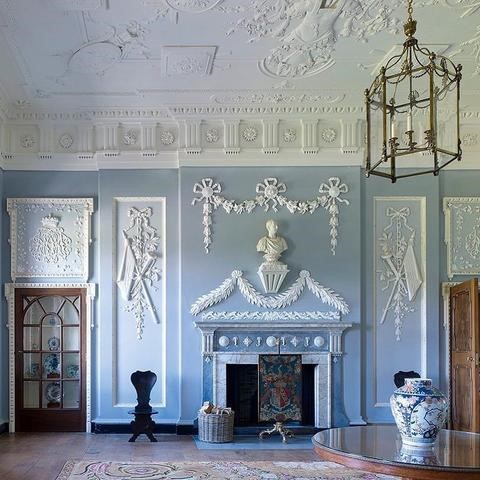
Client: Mr Oliver Burge and Mr Hugo Burge
Lead Contractor: Smith and Garratt, Surveyors
Marchmont is a major Palladian mansion in the Scottish Borders, between the small towns of Greenlaw and Duns. It was begun in 1750 for the 3rd and last Earl of Marchmont, possibly as a late design by the celebrated architect James Gibbs. The model was clearly Houghton Hall in Norfolk, the palatial creation of Marchmont’s political rival Sir Robert Walpole, in whose design Gibbs had had an important role. In 1912 the estate was acquired by a wealthy lawyer, Robert Finnie McEwen and the mansion remodelled by Sir Robert Lorimer, the leading Scottish architect of the day. The two principal interiors from the Georgian phase are the Saloon and Drawing Room, both with magnificent ceilings by the leading mid-18th century Scottish plasterer Thomas Clayton; they are amongst the finest rooms of their period in Scotland. Lorimer’s alterations also bequeathed a number of impressive interiors, especially the vast oak-panelled Music Room, dominated by an imposing organ and evoking the style of Wren.
In 1988 Mr. Oliver Burge, managing director of Marchmont Farms, had purchased some 3,000 acres of the estate (a further 2,500 acres followed separately in 2007). Mr Burge at this stage had no particular interest in the house, but in 2006, with the failure of the care home use, he and his son Hugo, fellow director, decided to take it on.
The house they acquired was in a reasonably sound structural condition, and it was dry at least, as it had been had been re-roofed by Sue Ryder
Foundation, but the modifications (and priorities) of its institutional use had inevitably degraded the condition of the interiors and had created many unappealing quirks in the house layout. It was clear that major structural work would be required to both restore the integrity of the house as designed.
Finding a viable future for a house the size of Marchmont in a remote rural setting presented a major challenge. The Burges concluded that the best way forward would be effectively to divide the building into functionally separate units without compromising its architectural integrity. These would comprise the Georgian state rooms on the piano nobile, including large and small dining rooms; meeting rooms for conferences, including the music room and a film room; one main apartment that could be rented separately; self-contained flats for a housekeeper and caretaker; various estate offices; and, on the top floor, an eight-bedroom apartment that could be let to shooting parties and others.
Firstly, the strategy was to recognize this in the way that the interiors of the piano nobile, in particular, were restored and furnished. Thus, the core of the house was distilled to its Georgian essence, with the original period given preeminence not only in the two main staterooms (Saloon and Drawing Room) but also in the smaller adjoining rooms (Boudoir and Small Dining Room). In the Boudoir in particular, with the support of Historic Scotland the key Lorimer elements of chimneypiece and panelling were removed and relocated more appropriately elsewhere in the house. From a sample of two surviving original Georgian panels the room was completely refitted and complemented by a fine late-18th century marble chimneypiece, making together a convincing Georgian ensemble. A series of other elements across these rooms were removed and re-used elsewhere in the House, as per planning requirements. The result is a Georgian core, with a Lorimer layers within it, that feels natural, imposing but like a home.
The scheme was worked out in close and supportive consultation with
Historic Scotland, which realised the urgent need for a realistic solution, and planning consent was granted in 2007, just before the financial crash of 2008 enforced a lengthy pause on progress. In 2012 the owners were in a position to pick up the threads of the project, having used the interval to refine their ideas and to focus on acquiring the kind of furniture and other works of art that they felt the quality of the interiors demanded to augment their own inherited collection. This has resulted in the principal interiors being furnished with furniture, paintings and objets d’art that are appropriate to the varying periods of the rooms and are in many cases of museum quality. As far as possible the items acquired have had a Scottish provenance, and in some cases it has been possible to reacquire items that were originally at Marchmont.
In restoring and finding new uses for one of Scotland’s most important but least known country houses, the aim was to involve local firms and individual craftsmen as far as practicable, and in the event over 85% came from south-east Scotland. The restoration was completed in early 2017.
The result has been truly remarkable, and seeing the house today it is very hard to believe that only a few years ago the magnificent interiors were obscured by institutional use, with not a single piece of historic furniture remaining in the house.
Highly Commended: Mount Stewart, Co. Down, Northern Ireland
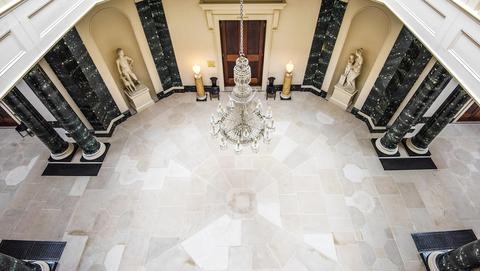
Client: National Trust Northern Ireland
Lead Contractors: H&J Martin Ltd, Lagan Construction Group
Situated on the Ards Peninsula, on the eastern shore of Strangford Lough in Northern Ireland, Mount Stewart started life in the 18th century as a villa by the sea for Alexander Stewart and his friends, and has retained this feeling of relaxation and entertainment ever since.
The Stewart family were involved in many areas of public life and although Mount Stewart was only one of the several houses owned by the Londonderrys in the 19th century, it remained a regular residence. Viscount Castlereagh (1769-1822, 2nd Marquess of Londonderry from 1821-22) was perhaps the best known member of the family, who played a key role as British Foreign Secretary during the Napoleon Wars and the political settlements that followed, in particular, master-minding the Congress of Vienna. The 7th Marquess of Londonderry continued the tradition of a life devoted to politics and on becoming Minister for Education in the newly formed Northern Ireland Government in the 1920s, Mount Stewart became the hub of the family’s enthusiastic social and political life once more.
It is to the 7th Marquess, his wife Edith and their youngest daughter, Lady Mairi, that we owe the real character and beauty of Mount Stewart today and its gardens of international importance.
This £8.5 million conservation & restoration project was designed to address structural failings in the house, the overdue replacement of electrical wiring, fire and security systems, and to introduce environmental control to this Accredited Museum. It was established that the structural failings were caused by inadequately supported and excessively long, weight-bearing beams and joists, resulting in cracked ceilings and beams, deflecting floors and subsiding walls.
At the same time the Trust set out to improve significantly the presentation of the house, and recapture the essence of its heyday from the 1920s to the 1950s. A backlog of conservation work needed to be addressed, while many of the interiors looked tired and shabby- a look completely at odds with the status and spirit of this great house.
A Conservation Management Plan was produced by the Curator which greatly increased the team’s understanding of the historic changes to the house and the significance of interiors and finishes. The Curator worked closely with the current family representative; the CMP revised The Trust’s ideas of how this house developed and was used over the years; it helped the Trust devise clear presentation proposals for the rooms based on the family’s use, especially the impact of Lady Londonderry from 1920 to her death in 1959. It helped develop the underlying philosophy for the whole project.
The house was kept open to visitors throughout the project, enabling the show-casing of much conservation work, carried out in situ. This also encouraged many volunteers to join the team during the project to carry out invaluable labelling, cleaning and packing for safe storage of the many thousands of objects and books in the house, and subsequent unpacking and re-presentation of the house.
The joinery work was carried out by an in-house team, including training posts and apprenticeships. Volunteer interns also supported the work of the furniture conservator and the project conservator. This element of training and up-skilling formed a fundamental part of the project.
The settlement of the Estate of Lady Mairi Bury, daughter of Edith and Charles Londonderry, and who died in 2009, has enabled the Trust to open an additional 34 rooms available for public access (including bedrooms and bathrooms), and saw the vast majority of the contents of the house being transferred to the National Trust via AIL and purchase.
The conservation project has revitalised the house, reviving finishes and improving lighting, giving the house a lived-in and well-maintained feel. Through careful and prioritised conservation, restoration or replacement of upholstery, furniture, paintings, curtains and carpets, the house feels like a family home to which visitors are welcome guests.
Cleaning the degraded varnish from the painted marble columns and reverting back to the original stone colours in the Central Hall has had a huge impact on this space which is the heart and soul of the house, and is the most dramatic architectural space. This last winter (2016-17) saw the removal of the 1960s linoleum chequer-board flooring, which had been laid onto a thick bituminous screed over the original sandstone floor. Careful removal of the linoleum and the screed, conservation cleaning and repair of the stone was carried out by Cliveden Conservation.
The project enabled the Trust to retain as much as possible of Lady Londonderry’s original decorative schemes, whilst refreshing the glazes, varnishes and other distinctive touches. The Trust aimed to refresh the overall feel of the house while not losing any of its decorative interest or authenticity.
The results of the project have been very well received by visitors and it has encouraged far greater numbers to visit the house. Prior to the project, there were around 30,000 visitors a year, while last year there were over 80,000. A 6-part documentary commissioned by Ulster TV, The Big House Restored, has also greatly increased interest in Mount Stewart and helped to enhance people’s understanding of the conservation work involved in such a project.
The funding was largely provided by the National Trust, with additional support from the Wolfson Foundation, the Laurtitzen Family Foundation and private donors.
Highly Commended: Euston Hall, Suffolk

Client: The Duke and Duchess of Grafton
Architect: Francis Johnston and Partners
In its present form, Euston Hall comprises about half of the mansion which existed before the Second World War. At its core was a Tudor house, reconstructed in the “French manner” in 1666-1670 and again in strict Palladian style by Matthew Brettingham for the 2nd Duke of Grafton in 1750-56.
In 1902, fire gutted the south and west ranges but the north range survived. The house was re-constructed on the original lines (using fireproof construction) but with plain interiors.
In 1950-52, it was decided to demolish the Edwardian parts and retain only the historic Brettingham north wing and part of the west wing containing the big dining room (to house the C17th family portraits) with bedrooms over.
In that form the house was lived in unchanged for two generations until the present Duke succeeded his grandfather in 2011. The fabric had been well maintained but the interior arrangements with cramped kitchen quarters, tired decorations and comparatively few (austere) bathrooms, were in need of upgrading to make it suitable for a new generation of family life, and to improve the practical working of the house.
The heating, hot water and electrical services have been renewed throughout. At the western end of the north range, a large family Kitchen has been created out of three cramped 1950’s spaces and it has been linked by a new “bridge” over the back door corridor to a new west facing Family Room, formed by raising the floor level in the former Billiards Room.
The Entrance Hall has been enlarged and made symmetrical by taking in an adjacent cloakroom. The C17th bolection moulded marble chimneypiece was relocated from an attic bedroom. The Drawing Room, formed from two C18th panelled rooms in the 1950’s, has had the panelling reinstated on the east wall and the crude structural opening between the two rooms clad with Ionic pilasters and a panelled soffit.
A Library has been formed in the former Duke’s Study with bookcases inspired by William Kent and a new chimneypiece copied from a Kent design at Wakefield Lodge, a former ducal property.
On the first floor, the picture gallery known as the Red Square has been greatly enhanced by fitting an oval laylight within the large rectangular Edwardian skylight and replacing the spindly balustrade to the well with robust newels and balusters copied from the adjacent C17th staircase. New bathrooms have been created for the principal bedrooms, adopting motifs from elsewhere in the hall in their design.
In the process of removing a wall between the Balcony Bedroom and a redundant corridor in the Edwardian West Wing, an enormous steel beam 4’0” deep was uncovered, which could not be removed. The disguise of this beam called for some design ingenuity, the result being a modified Serlian motif with twin columns and a fan infill to the solid tympanum.
As well as improving the practical working of the house, the aim has been to enhance its architectural character by judicious alterations and restorations, underpinned by a thorough understanding of its history.
Restoration of a Georgian Town House
Winner: 14 Fournier Street, London
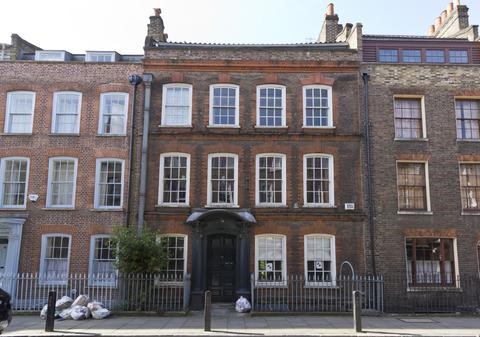
Client: Ben Adler and Pat Llewellyn
Architect: Julian Harrapp Architects
No. 14 Fournier Street was built in 1726 by William Taylor, a joiner and woodworker, for his own family home.
The house is four bays wide, on three floors plus basement and an attic storey with garret windows; a common feature of Spitalfields houses with its history of domestic fine silk manufacturing.
The front elevation is built of grey stock bricks with finely rubbed red brick, segmental, window arches and dressings. A red brick cornice at parapet level was added in the 1980’s.
Until purchased by the present owner in 2014, the house had been in single ownership since its rescue from the threat of demolition in the early 1970’s.The project commenced as a relatively straightforward refurbishment project with internal and external repair of the historic fabric, new bathrooms and kitchen and new M&E services.
However, an initial inspection with the structural engineer, Hockley & Dawson, quickly established that the central spine wall was virtually non-existent. A steel beam spanning across the house had been installed in the roofspace during the 1970’s and steel and timber posts had been added in the garret bedroom and in the ground floor reception room to help support the fragile spine wall.
New steel columns replaced the existing posts in the garret bedroom and these were concealed firstly, behind a timber pilaster in the Entrance Hall and a second one concealed within the existing timber column at third floor level.
Externally, brickwork was repaired and repointed, the roof repaired and retiled and new lead parapet gutters installed. The front street railings were repaired and three unknown bricked up vaults under the road were discovered, repaired and re-opened. A new cast lead hopper was added to the front elevation and the fanlight over the front door was carefully repaired by a specialist conservator.
The architectural aim for the project was to bring the house up to present day standards, address the very serious structural issues and present a comfortable home, whilst retaining the evidence of history, structural distress and severe wear and tear through almost three centuries.
This perceived light touch concealed an extraordinary amount of dedicated work by highly skilled craftsmen.
Highly Commended: 44 Long Street, Tetbury, Gloucestershire
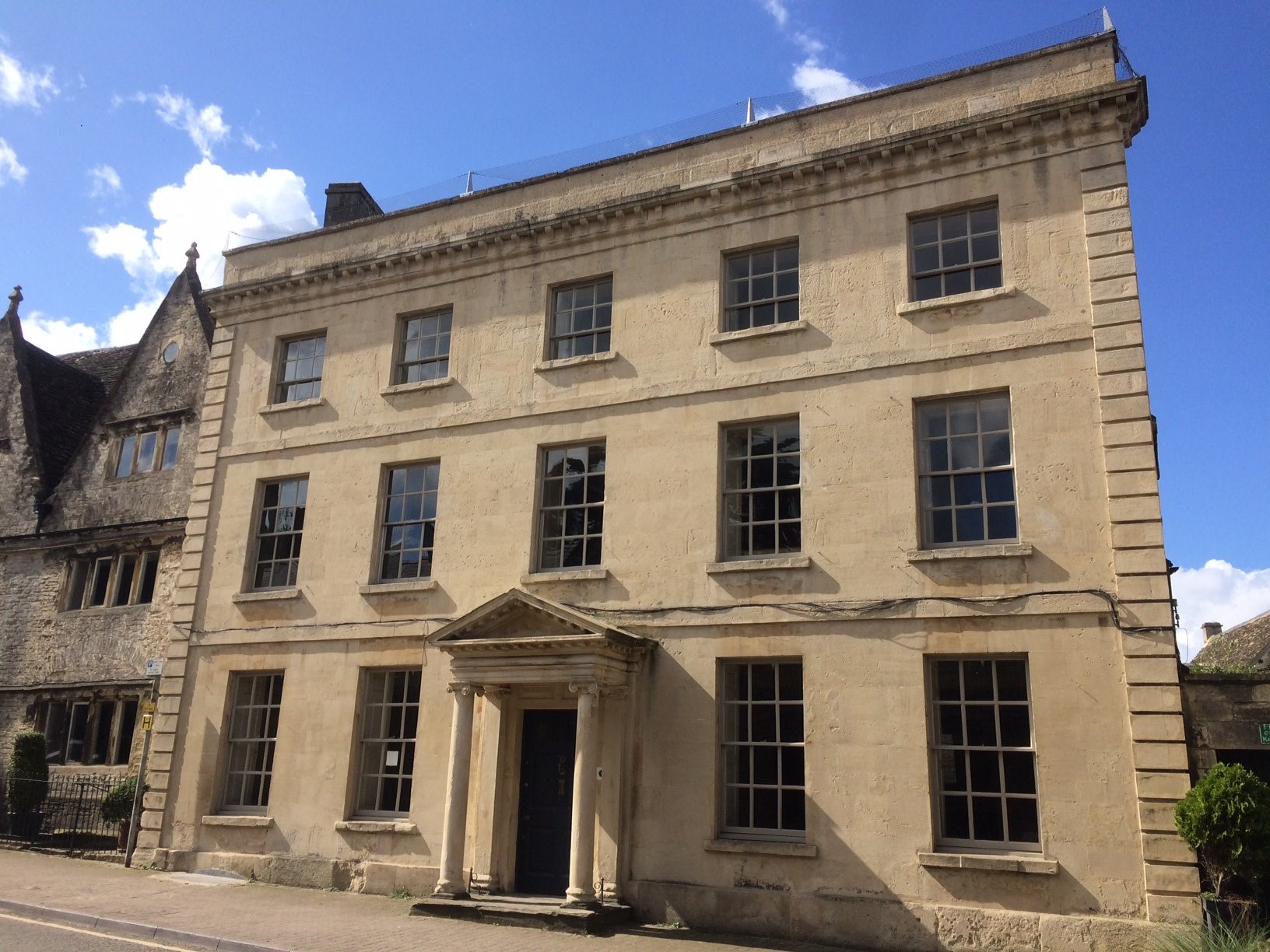
Client: Nine United Properties UK Ltd
Architect: Chris Dyson Architects
44 Long Street is a historically and architecturally important building occupying a prominent position within the principal street of this small Gloucester-shire town.
This front range is attached to an earlier late 16th or early 17th century wing which is in separate ownership. This project rationalised this divided ownership and the internal circulation to the eighteenth century, front range.
The existing stair is a wide, fine eighteenth century staircase with barley sugar turned balusters, a frog back handrail and column newalls. The base of the handrail at ground level terminates in a scroll with grouped balusters. This stair is integral to the plaster mouldings to the cornice and ceiling rose at first floor level.
The second floor, with its lower ceilings, poorer quality glass and lack of architectural mouldings would have been originally housed servants accommodation. It was decided that the new stair, if designed as a separate ‘servants’ stair’ could be built without affecting the setting of the principal stair. This new staircase is housed in the first floor side room, an asymmetrical room without a detailed cornice where the position of the principal floor beam allows this insertion without major alteration.
The proposed stair therefore has less impact than a continuation of the main stair and little loss of his-toric building fabric. The works to the building also included a number of repairs to the fabric including the front entrance porch which had signs of structural movement, possibly impact damage.
The project not only restored the damaged fabric of this fine Grade II building, but reconnected the redundant second floor and attic to the ground and first floors, restoring the historic circulation of an important house which had been poorly served by insensitive subdivision.
Highly Commended: 9 Somerset Place, Bath
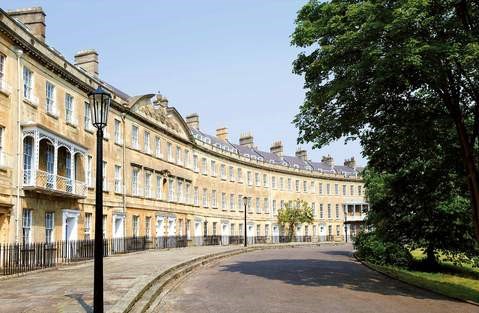
Client: Mr and Mrs. N Gilpin
Architect: Jonathan Rhind Architects
The Grade I listed Georgian house is part of Somerset Place, a crescent terrace and important part of the Georgian Period and World Heritage Site status in Bath.
The house was privately bought in September 2013 and was previously redundant from 1950’s University accommodation use.
Previous unsympathetic alterations to multiple occupancy student accommodation included subdivision of the plan form and introduction of intrusive services.
The house is of particular interest as a Grade I listed building, most of which was intact with original plaster and fabric despite its previous use. Many of the works that had been carried out to the building subsequently were additions which could be removed to expose the original 18th century building and its later historic alterations.
The purpose of the project was to reinstate a fine Grade I historic house to a single-family dwelling which benefits the people living there and the long cultural and aesthetic history of Bath, Georgian England and the way it has endured through subsequent generations.
An initial contract to remove the 1950’s university insertions and services enabled detailed analysis of the original layout and fabric to inform the reinstatement of the original plan and details. This understanding was vital to allow modern services, bathrooms etc. to be incorporated while repairing or renewing historic fabric and finishes.
Most of the work involved the removal of late 19th and early 20th century services and alterations, so that the original late 18th century design intentions and fabric was visible. Alterations and repairs were carried out to exceptionally high standards of craftsmanship and materials, so new work will weather and age as gracefully as the older parts.
Diaphoros Prize
Winner: Reads Cutlers, 4 Parliament Street, Dublin, Ireland
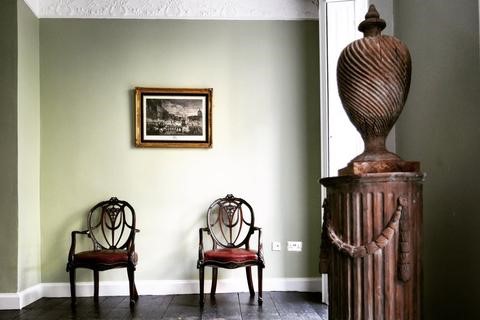
Client: Reads Cutlers
Architect: Kelly and Cogan Architects
Reads Cutlers at 4 Parliament Street and 3 Crane Lane is a unique part of the commercial history of Dublin City. Trading in Dublin since the 1670’s (originally at Blind Quay) and in its present location since the 1740’s Reads was a lucrative family business trading in swords, knives, forks, and medical instruments.
The building is a conglomeration of built fabric dating from different construction periods: The earliest being the hitherto unrecognised early 17th / 18th century premises fronting onto Crane Lane which were later absorbed into the mid18th century Wide Streets Commissioners alterations which front onto Parliament Street. Both 3 Crane Lane and 4 Parliament Street were, at the date of the current owners purchase of the premises, in extremely poor condition. Ingress of rainwater from both the roof and the internal light-well which separates the two parts of the premises, had caused significant loss of integrity to masonry and rot infestation of timbers.
More seriously, historic alterations at ground and first floor dating to the 1790’s whereby two rooms in 4 Parliament Street were conjoined into a single space on each level, had resulted in a serious destabilisation of an already delicate structure, resulting in serious movement and loss of cellular structural integrity essentially resulting in a situation whereby much of the internal structure was supported on two cracked cast iron columns inserted in the 1840s to address destabilisation such that at ground level the subsidence across the shop floor was measured diagonally at approximately 16 inches.
The primary interventions were structural and involved the insertion of new steel supports and stanchions to relive the stresses and impact upon the building of 250 years of alterations, adjacent developments.
A number of problems had become apparent almost immediately, focussing around late 18th century and early 19th century alterations carried out to the building.
These necessitated careful stripping out of joinery fabric and fittings and the insertion of temporary support structures to allow for the insertion of new steel-work designed by LMC Consulting Engineers. The poor condition of the staircase, internal window casings and shop-front presented particular problems and which involved careful dismantling of the shop-front, its disassembly into its constituent parts and intensive conservation repair and re-assembly by Conservation Joiner Paul Lawrence.
Special Commendation
Burn Croft, High Street, Barrow upon Humber, Lincolnshire
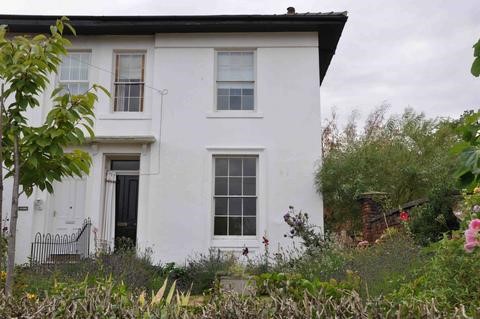
Client and project manager: Mrs. Julie Roberts
Burncroft is an attractive semi-detached villa of c.1840. It was identified as a building at risk by North Lincolnshire Council in 2005. The interior had been little altered, but the property had suffered from decades of neglect with the roof, plasterwork, brick, windows and stucco all requiring serious attention. Over fifteen years the owner carefully restored this property, while living in it, removing 1930s chimneypieces and replacing them with late Georgian examples, including the replacement of a stolen original chimneypiece, and painstakingly repairing and reinstating lost elements of this modest but elegant building.
This is a commendable example of a restoration scheme undertaken on a very tight budget, with much of the work being undertaken by the owners themselves. The external render has been repaired following a chemical analysis of its constituent parts (Roman cement coloured by local silt from a nearby river) and lost decorative features reinstated. Internally, lime plaster has been carefully repaired where possible. The windows and shutters have also been carefully repaired as has the main and service staircases. What is very striking is the way that the owners have researched each stage of the repair process and found local craftsmen who were willing and able to undertake conservative repairs using traditional materials.
The restoration of Burncroft admirably demonstrates what can be achieved with limited resources, and its restoration has transformed a building which was at risk into an ornament and exemplar to the conservation area in which it sits.
Object in a Georgian Context
Winner: Grimsthorpe Gates, Grimsthorpe Castle, Lincolnshire
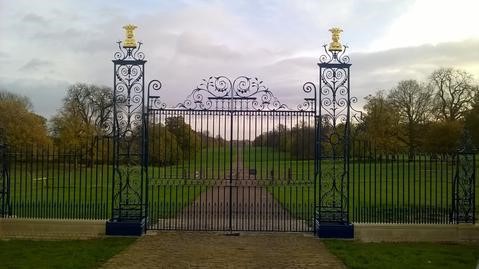
Client: The Grimsthorpe Estate
Designer: Todd Longstaffe-Gowan Landscape Design
Grimsthorpe Castle is a heritage asset of the greatest importance. The historic park and
garden are registered Grade I and the Castle building is listed grade I. Therefore, when new entrance gates were proposed for the North Avenue, the greatest attention to the design and execution of the work was required. The proposed new gates, designed by Todd Longstaffe-Gowan in collaboration with the blacksmith Andrew Renwick, replace twentieth-century estate railings and a farm gate of good quality but unexceptional design. The design is intended to create a dramatic but sympathetic entrance to the North Avenue and the approach to the Castle. It echoes that of the north court screen, using the design language of Baroque wrought iron, and matching it in terms of quality of materials. A straightforward copy was considered inappropriate not only as a response to a historical model, but also given the design hierarchy which places a gate at this distance from the Castle below the gate into the north court directly below the principal front. The new gates introduce a new frame into the long-distance but important view of the Castle, and they also redefine the North Avenue in the key view into the park from the A151. The new gates, by the quality of their design and execution, greatly enhance the grandeur of the North Avenue and the Castle as a grand vista and emphasising its role as the principal approach.
Highly Commended: Sir John Soane’s Masonic Ark, The Grand Temple, Freemasons Hall, London

Client: The United Grand Lodge of England
Craftsmen: Houghtons of York
The Great Hall that Sir John Soane designed for the Freemasons was one of his greatest interiors. At the centre of this hall, underneath its dramatic hanging ceiling, stood Soane’s monumental ‘Ark of the Masonic Covenant’, a piece of ritual furniture built in honour of the unification of Ancient and Modern Masonic Lodges in 1813. Sadly nothing of this architectural ensemble now survives. The Great Hall was lost during remodelling of the site in the 1860s, and the Ark was destroyed by fire in 1883.
Master Woodcarvers Houghtons of York were commissioned to create a replica of Soane's original piece. The information provided for the recreation was limited with only a few original sketches and a handful of paintings where the Ark is featured in the background. The project has been one of cooperation between the Library and Museum of Freemasonry, Sir John Soane’s Museum, the Factum Foundation for Digital Technology in Conservation and master wood carvers Houghtons of York.
The Factum Foundation is an organisation that uses digital technology to accurately record heritage items for conservation purposes, to enable facsimiles to be produced and, as in the case of this project, to reconstruct lost items.
Houghtons of York is an old family firm that uses traditional methods and materials to produce new architectural woodwork or furniture, as well as to restore and reconstruct damaged and lost items. The combined efforts of these two firms have produced a superb and accurate reconstruction of one of the lost treasures of Grand Lodge.
The Ark will then be transported to the Royal Albert Hall for the Masons’ great Tercentenary celebration, where it will be dedicated by the Grand Master. Afterwards it will, like the original, take its place in the Grand Temple as a permanent memorial.
Highly Commended: Stowe Gothic Cross, Stowe, Buckinghamshire

Client: Stowe House Preservation Trust
Project Lead: Fred Markland, National Trust Building Surveyor
Craftsmen: Cliveden Conservation
Built in 1814 from Coade stone as the first Duke’s memorial to his mother, the gothic cross at Stowe was three tiers high and very ornate. When some intrepid Stoics came across some pieces of the cross in the undergrowth in the 1970s, it gave a peep into a lost garden monument. Now, with these pieces, the National Trust recreated the cross, destroyed by a falling tree in the 1950s. Bringing the Gothic Cross back to Stowe, unfortunately, wasn't as simple as putting everything back together. Many of the fragments were missing or unusable. This combined with the lack of historical information about the monument meant it was never going to be a small task. A combined effort between Cliveden Conservation and National Trust staff along with hundreds of hours of research allowed the team to discover how the monument looked, how big it was, and most importantly, how it was constructed.
Using twenty-first century 3D scanning and CAD models, an accurate computer-based representation was created. Cliveden Conservation could then carefully re-create the 120 pieces needed to make the finished cross. Three of the four original base panels were in a good enough condition to re-use as part of the new monument.
Another hurdle for the team to overcome was the material to build with in the first place. Coade stone was invented in the 1760's by Eleanor Coade. She created a formula using specific measurements of glass, china clay, silicates and other materials fired at an extreme temperature for certain amounts of time. The finished result was a strong, hard and resilient ceramic seen more as an artificial stone. After her death in 1821, the recipe was lost and production came to an end. Careful experimentation and research around the old factory, lead to the creation of a new recipe, allowing for the stone to be reproduced once again. This has allowed for the repair and re-creation of sculptures like the Gothic Cross which was not possible before.
Highly Commended: Holkham cricket Pavilion, Holkham Hall, Norfolk
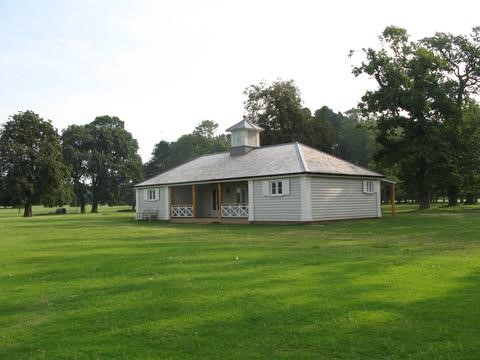
Client: Coke Estates Ltd
Designer: George Carter Garden Design
The proposed new timber framed cricket pavilion replaces an existing timber building which was made up of two “off the peg” timber sheds. Cricket has been played in the park at Holkham since the early 1840’s when the 2ndEarl arranged for part of the grounds to be levelled to make a square. The site of the pitch was marked by 3 flagstaffs– these remained in situ for many years. In the 1920’s one of his successors, who was a real cricket enthusiast, arranged for the square to be properly laid by the staff at Lords. In its heyday, the square grew to 125 feet across and up to 60 matches were played on it each year. The site to the north of the house was obviously chosen as it required less levelling than other parts of the park. The new pavilion is designed as a simple timber framed building with very basic ornamental detail in the form of architraves to the windows, corner boards and a simple timber balustrade. A small clock turret diversifies the deliberately low roof line. The timber frame of the building will has painted, clapboard cladding and painted timber detailing. The windows are of painted timber. The colour is a light stone colour with a slightly lighter tone for the windows, doors and mouldings. The structure stands on 3 courses of grey brickwork. The roof is of cedar shingles with lead hips and the rainwater goods are of painted cast iron. The pavilion not only replaces an unattractive utilitarian structure, but demonstrates that beauty and utility can be combined, and can enhance even the most significant of historic landscapes.
Highly Commended: Blandford Parish Church Cupola Project, Blandford Forum, Dorset
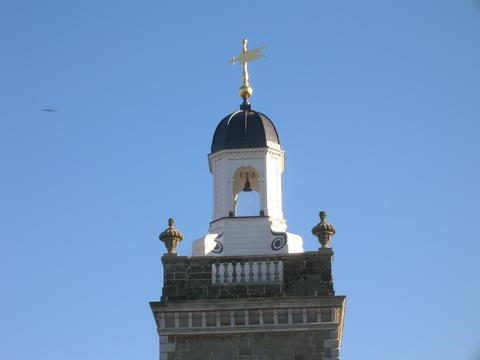
Client: The Parish of Blandford Forum
Architect: Benjamin + Beauchamp Architects Limited
First installed on the church tower in 1758, the cupola was clad in sturdy weatherboarding with curlicues on the corner vanes and decorative gilding on the weather-vane at the top. Successive repairs over the years were mostly done with poor materials, including marine plywood. The deterioration of this local landmark resulted in a project to restore it to its former glory, and involved rebuilding the structure in solid oak. The original decoration of the cupola was also restored, and the weathervane repaired and reinstalled, having been removed many decades ago. Ironically enough, the cupola was not even part of the original design. The brothers John and William Bastard had been placed in charge of the re-building of Blandford after the devastating fire of 1731, which destroyed the entire centre of the town. They completely re-built the Market Place: every building was new, hence its stylistic coherence. The new church was on the site of the old medieval one, and it was intended to be a statement of Georgian grandeur, complete with a spire on the 80 foot high western tower, which, according to John Bastard’s drawing, would have added another 70 feet to the structure. But the money ran out (‘there is no new thing under the sun’, as Ecclesiastes puts it) and in 1758 a wooden cupola, adding a mere 25 feet in height, was used instead. It was almost certainly the work of Nathaniel Ireson, an architect of Wincanton who had already worked on Stourhead House. Despite this respectable pedigree, John Bastard was disgusted by this ‘temporary wooden structure’ and commented that ‘it will keep neither the wett nor the water out’ – perhaps a little stern considering it has lasted for some two-and-a-half centuries: it was only poorly executed repairs to damage from a lightning strike in the 1960s which brought about its present plight. The restored cupola now, literally, shines and acts as an incentive to continue the series of repairs which this fine Grade I church needs and deserves.
Share this Post

